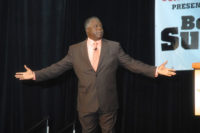Best of Success: OSHA and the Employee Misconduct Defense
“Why are we here?” attorney Doug Ehlke asked attendees at Best of Success. “You’re number four on the hit list of OSHA.” Ehlke, owner of Ehlke Law Offices in Federal Way, Wash., dispensed some tips on dealing with OSHA in the event of an accident on the jobsite and detailed the elements of the unpreventable employee misconduct defense.

“Why are we here?” attorney Doug Ehlke asked attendees at Best of Success. “You’re number four on the hit list of OSHA.” Ehlke, owner of Ehlke Law Offices in Federal Way, Wash., dispensed some tips on dealing with OSHA in the event of an accident on the jobsite and detailed the elements of the unpreventable employee misconduct defense.
According to Ehlke, the employee misconduct defense is designed to identify “isolated and unpredictable behavior by employees that the employer would not be expected to know of, even with the exercise of due diligence.”
In the event of a citation, OSHA must prove that there is an applicable standard for the situation, employee exposure, and employer knowledge. There are four elements to the employer’s defense, said Ehlke, and the employer must prove all four:
1. The employer must have established work rules.
2. Work rules must be adequately communicated to employees.
3. The employer must take steps to discover violations.
4. The employer must enforce the rules in a manner that is effective in practice.
“You must train your employees - supervisors too - and quiz them on it,” said Ehlke. He suggested that jobsites be periodically checked and monitored, and that visits should be documented with photos. Photos should show workers following applicable standards and work rules and be dated and timed. “Pictures win cases,” he said.
“It’s important that employers know their rights,” said Ehlke. “How can you protect yourself if you don’t know what to look for?”
OSHA’s rights include the right to conduct an inspection, either with consent or a search warrant. They have the right to use a video camera, but cannot record voices without notice and consent. “Don’t let them,” advised Ehlke.
Employers and employees have the right to have a lawyer present for the walkaround, conferences, interviews, and testimony. They have a right to reasonableness of the agency’s demands and the right to be prepared.
In the event of a problem, when should contractors get their lawyer involved? “Immediately,” said Ehlke, “especially where repeat or willful citations may be anticipated and the inspection follows an accident, fatality or employee complaint.”

Ehllke
“Why are we here?” attorney Doug Ehlke asked attendees at Best of Success. “You’re number four on the hit list of OSHA.” Ehlke, owner of Ehlke Law Offices in Federal Way, Wash., dispensed some tips on dealing with OSHA in the event of an accident on the jobsite and detailed the elements of the unpreventable employee misconduct defense.
According to Ehlke, the employee misconduct defense is designed to identify “isolated and unpredictable behavior by employees that the employer would not be expected to know of, even with the exercise of due diligence.”
In the event of a citation, OSHA must prove that there is an applicable standard for the situation, employee exposure, and employer knowledge. There are four elements to the employer’s defense, said Ehlke, and the employer must prove all four:
1. The employer must have established work rules.
2. Work rules must be adequately communicated to employees.
3. The employer must take steps to discover violations.
4. The employer must enforce the rules in a manner that is effective in practice.
“You must train your employees - supervisors too - and quiz them on it,” said Ehlke. He suggested that jobsites be periodically checked and monitored, and that visits should be documented with photos. Photos should show workers following applicable standards and work rules and be dated and timed. “Pictures win cases,” he said.
“It’s important that employers know their rights,” said Ehlke. “How can you protect yourself if you don’t know what to look for?”
OSHA’s rights include the right to conduct an inspection, either with consent or a search warrant. They have the right to use a video camera, but cannot record voices without notice and consent. “Don’t let them,” advised Ehlke.
Employers and employees have the right to have a lawyer present for the walkaround, conferences, interviews, and testimony. They have a right to reasonableness of the agency’s demands and the right to be prepared.
In the event of a problem, when should contractors get their lawyer involved? “Immediately,” said Ehlke, “especially where repeat or willful citations may be anticipated and the inspection follows an accident, fatality or employee complaint.”
Looking for a reprint of this article?
From high-res PDFs to custom plaques, order your copy today!




